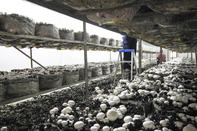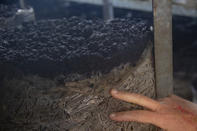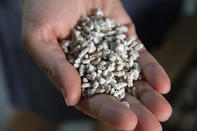Mushrooms are grown in large indoor facilities where the level of carbon dioxide, humidity and temperature are carefully controlled. It is a highly technical process, geared to the mass production of mushrooms, especially in the case of button and brown mushrooms - all members of the Agaricus spp.

Mushroom farming is a scientific operation that requires meticulous record-keeping to achieve consistent results and requires a large capital outlay. In addition, it is highly technical and needs a variety of parameters in perfect balance to produce good quality mushrooms, says Dr. Martmari van Greunen of Sylvan, a company that supplies mushroom spawn.
Other challenges in mushroom farming include cultural resistance to eating mushrooms and a relatively short shelf life, with a need for a cold chain from farm to shelf.
Mushroom Growing

Specially-made compost is spread on trays, shelves or filled into plastic bags. Mushroom spores in the form of ‘mushroom spawn’ are then incubated in the compost and allowed to form a network of mycelium - mushroom ‘roots’. This process of forming a mycelium network and colonise the compost is called ‘spawn run’ and takes 15 - 19 days.
To stimulate the mushroom mycelium to convert from the vegetative to the reproductive phase, a 5 cm layer of special material - the casing - is added on top of the compost. This casing layer usually consists of a peat moss mixture, imported from Ireland or the Netherlands. Sugar cane pith (a byproduct of paper manufacturing from sugar cane) is mixed with the peat moss to increase the acidic pH to a more neutral level or alkaline pH of about 7.5. The casing layer provides moisture and a suitable microclimate for the mushroom pinheads to develop.
Growers will then reduce the temperature in the growing rooms with the use of sophisticated climate-controlled units. This thermal shock causes the mushrooms to start fruiting and forming mushrooms in a process called ‘pinning’. During pinning, mushrooms double in size every 24 hours and must be checked daily to ensure optimum harvesting.
Harvesting of Mushrooms
Mushroom fruiting occurs in breaks or flushes. This begins about 17 days after casing and continues at weekly intervals. In general, three breaks are picked before the spent compost is removed to make room for the next crop.
Mushrooms for fresh consumption are mostly hand-harvested, graded and packed in punnets or bulk packed (up to 5 kg) in cardboard containers. The best storage for mushrooms is in a cold room at 2 - 4°C with high relative humidity.
Second-grade mushrooms (e.g. too mature or blemished) are sliced and used for pizza toppings, in sauces etc. Mushrooms for canning are mostly machine picked.
Mushroom Spawn

Mushroom spawn is a material (such as sterilized rye or sorghum kernels) that is inoculated with spores of a specific mushroom strain. The mushroom spawn serves as the ‘mushroom seed’ that is ‘planted’ in the growing substrate - the compost. It is mixed into the compost at a rate of 8 litres per ton or 0.5% by weight. The spawned compost is then filled into bags, trays or shelves for incubation or ‘spawn running’.
Spawn running, as well as the cropping takes place in growing rooms or tunnels that are well-insulated and equipped with an air-handling system. Air needs to be filtered to prevent bacteria and fungal spores from entering the growing rooms. In addition, air, temperature and moisture are carefully regulated to control the growing process.
By Marinda Louw